NAT Events - invitations to the Foundations presidency
to participate in external events (member's abbreviation)
January 31, 2008:
Project report of the foundation for Tropical Nature and Species Conservation (NAT) on project execution 2001 - 2007
Dragon Tree Rain Forest Maromiza in Andasibe-Anevoka, Madagascar
Initial Situation
Madagascar is the fourth largest island on earth with a special history. Around 70 million years ago, the island had separated ultimately from the African continent. Since then, it has had
its own evolution with a flora and fauna that can only be found here and nowhere else in the world. Especially this unique nature is now particularly endangered by man. The island,
which had formerly been completely covered by wood, was colonised by man only 1000 years ago. Most of them came from close-by Africa, others came with boats along the coasts
from the indomalayan archipelago. Over the centuries, the immigrants developed towards one people consisting of nineteen ethnics with a common language. By now, around half
the people have converted to Christianity, the others worship various natural religions, but the living of the Christian population is still strongly influenced by their aboriginal belief.
Thus, special ancester worship and many taboos (Fadys), influenced by weather, various days or daytimes, certain plants and animals impose obligations on people which strongly affect
modern development in the western sense. Also for this reason, Madagascar belongs to the 10 poorest countries in the world.
The village of Andasibe and some fragments of rain forest are situated only around 100 miles to the east of the capital Antananarivo. Since 1989, Helmut Zimmermann, and later the
NAT foundation, got involved there with habitat investigation for species and nature conservation. By then, the local population had predominantly lived on utilisation of the wood,
especially on slash-and-burn nomadic cropping. In their opinion, their ancestors had left behind the wood for their utilisation. For two or three years, the ashes of the burned wood and
the very thin humus layer allow a secure yet moderate harvest, however with the effect of eroded soil. Then, the next area of wood is slashed and burned, and so on. With the new
government, further damage to the remaining rain forest became prohibited, which even increased poverty. We immediately became aware of the fact that behaviour modification of
the population and the protection of their nature can only be achieved by confidence building and comprehension of our projects. This was realised for example in1991, when we
assisted with planning a drinking water supply, with the realisation of sports activities for the youth (the two "football clubs" of the village lacked a football since two years),
but to much greater extent in 1994, when the village was flooded by a huge cyclone which took a heavy toll on human life, pets, homes, and cultivable land. Our spontaneous collection
in Germany brought first aid to the poor population of the village. But in our village meeting, plans and photos also confronted them with the fact that eventually they themselves
had caused the eroded hillsides and the floods by their slash-and-burn behaviour.
Madagascan Golden Frog (Mantella aurantiaca)
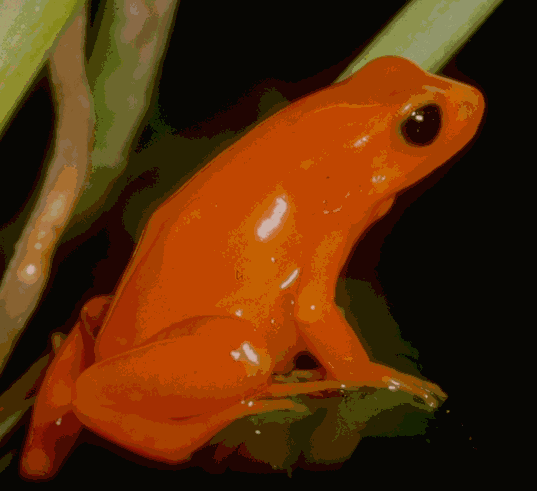
With the above mentioned and further confidence-building measures, and after years of collaboration with the Madagascans, we succeeded in persuading them of the value of
their rare fauna and its protection (e.g. to set the Madagascan Golden Frog, which only lives here, on CITES), but also of the conservation of the rain forest marsh area, the habitat
of the frog, which is now the "flagship species" of further 688 species in this area. After our extensive preparatory work and petitions, the area of 20.750 acres in size
was added to the RAMSAR list of the UNESCO as an important wetland world wide on February 2nd, 2005 (similar significance as an eco-label like "world nature
heritage").
Project goals and results to be expected
Due to our dedication we were invited by the national Madagascan organisation for nature conservation ANGAP to present our overall project with posters and large size
photos at the Madagascan exhibition stall of the world exhibition EXPO 2000 in Hannover. Then we were asked to help to relieve the distress of the population in the nearby
dragon tree rain forest area Maromiza and at the same time to save the flora and fauna of this unique wood area, which had already been degraded by two-thirds, from its final loss.
On February 26th, 2001 we therefore closed a contract with the responsible Madagascan ministry, which should assure the protection, the conservation and the scientific mentoring
of the Maromiza wood area on the one hand, but which, on the other hand, should also include the responsibility for the NAT foundation to provide new livelihood for the affected
population like
- Assistance with the inventory of the flora and fauna,
- Collaboration at the reafforestation (including collection of seeds, establishing tree nurseries etc.)
- Development of an eco-tourism which pays for itself in the forseeable future and which assures a lasting income for the population.
Especially the eco-tourism in Andasibe with already 33% of all Madagascan tourists in this species-richest region of the island with the most animals and plants, shows promising
sources of income. But there are preconditions:
- Education and employment of qualified tourist guides and rangers.
- Building of trails and nature trails with refuges.
- Environment education and general instruction for basic training.
- Building of a field station, where the rangers and the biologists can be accomodated and where education can take place (at the beginning of the financing by the
Landesstiftung Baden-Württemberg it had already been established).
By realisation of these goals we hoped to help the poor people to help themselves and thus give them new livelihood and opportunities to earn money, as well as
save the unique nature. Additionally we hoped to at least partly repair the missing link of the eastern rain forests by reafforestation of basic parts of the degraded wood area.
Progress in time and content
First, the Maromiza wood area of 4.000 acres in size was measured by Madagascan geometricians and marked with cairns and small signs to show that illegal utilisation of the
woods or hunt is no longer allowed here. A field station was not built by ourselves due to the undetermined ownership structure. Instead, a near-by cabin with electrical power and
water supply was rent. In this cabin we installed the NAT office and the accomodation for the head of the station, she is a Madagascan biologist. A comfortable room with tables,
blackboards, and the like served as a classroom and an assembly room. But due to a political crisis, the works had to be suspended as an entry to Madagascar was no longer possible
in 2002. In the meantime, the NAT foundation sensitised the German public to the problems of Madagascar with lectures and exhibitions. For example, an exhibition on Madagascar
was arranged at the botanical and zoological garden Wilhelma in Stuttgart, which lasted three months and attracted hundreds of visitors. But also high representatives of the newly
and democratically elected Madagascan government as well as representatives of the federal state of Baden-Württemberg and the German federal
government attended the exhibition and pleaded for the realisation of the goals of the NAT foundation (see exhibition catalogue).
Our work in Madagascar could be restarted in 2003. We started talks (meetings) with the people, the representatives of the local authorities, the administration of the district town
Moramanga and the ministries and their responsible departments in the capital Antananarivo. Soon we could establish a perfect collaboration with the new government. The minister
for the environment enacted a strict ban on slash-and-burn as well as deforestation. The park guards and the project manager started their work, and a NAT office was established in
the capital. The scientific examinations for the inventory of the flora and fauna were continued and reinforced, also in order to demonstrate the high value of this area to the Madagascan
authorities, the population and the eco-tourists. The project attracted special attention in public (press and television) on March 27th, 2004, when the president of Madagascar
accompanied by ministers and their attendants (12 people) landed in the Maromiza wood with two helicopters and made a short visit to the preliminary trails. Also the conferring of
the national order of the Republic of Madagascar to Helmut Zimmermann by the Madagascan president of the senate on May 24th, 2004 contributed to the NAT foundation's reputation.
Programmes on German television (ZDF, ARTE, and 3SAT) showed the work of the foundation in German- and French-speaking countries. The low-budget sourcing of the work
was still supported by private donators, by members of the NAT fundraising group, by the BIOPAT association (Patenschaften für biologische Vielfalt), by the
Bundesverband für fachgerechten Natur- und Artenschutz e.V. and the German embassy. But when no more funding for Madagascar was available to the main sponsor BIOPAT,
the completion of the overall project was at risk.
According to the contract between the NAT foundation and the Madagascan ministry of the environment, the project work had to be completed by 2007. The completion could
only be secured with an amount of over 50.000.- € which consisted of the approval of a higher amount of the Landesstiftung Baden-Württemberg and the inclusion of further
sponsors into the project financing like the Erwin-Warth Foundation for flora, fauna, environment, Conservation International with Tany Mewa, interest groups Phelsuma, PrimaKlima
weltweit e.V., Zoo Kölle Herr Landes, the Förderkreis NAT and private donators. The established long-term team of the NAT foundation consisted of the biologist Dr. Blanchard
Randrianambinina, representative of the NAT in Madagascar, the certified biologist Harisoa Vololonarivo, the gardener Mila Trasa, the rangers and guards Pafo Volontiana and
Hermano Raveloarison. Madagascan specialists of ANGAP contributed to the education for establishing tree nurseries and reafforestation, and due to the instructed reafforestation
works, around 60 families of the village could earn their living. Thus we were able to successfully achieve three targets from 2005 to 2007: Registration of the biodiversity and eco-tourism,
environmental education, as well as reafforestation with autochthonal plants. Additionally, we could sensitise the population for our work and give them a secure income.
Registration of the biodiversity and eco-tourism
"You can only conserve what you know". This was the proposition to sensitise not only the NAT scientists but also external researchers to make an investigation
in the Maromiza wood. It took place in a national and an international context by individually researching scientists, by groups of scientists (e.g. ornithologists, mammologists, and
entomologists of the National Museum for Natural History Stuttgart, primatologists of the University of Veterinary Medicine Hannover, and the GERP primatologists from Antananarivo)
or departments of the Antananarivo University (with over 40 botanists). The following table gives a survey of the biodiversity of the Maromiza wood, whereas the results of the
botanists had not been available when the table was set up.
DRAGON TREE RAIN FOREST MAROMIZA
ANDASIBE, EAST MADAGASCAR BIODIVERSITY AND ENDEMISM |
1.180 ha rain forest and 420 ha wasteland, Maromiza |
MADAGASCAR |
16 km2 |
587 000 km2 |
Fauna |
Species |
IUCN/CITES etc.
estimated |
Endemic |
Species |
Lemurs |
16 |
16 |
100% |
32 |
Other mammals |
32 |
>13 |
30% |
~90 |
Birds |
86 |
>28 |
87% |
~256 |
Reptiles |
20 |
>9 |
100% |
~290 |
Amphibes |
66 |
>2 |
100% |
~170 |
Lepidoptera |
461 |
? |
? |
? |
Coleoptera |
471 |
? |
? |
? |
Total |
1152 |
|
|
~838 |
|
as of 2006 |
as of 1994 |
as of 1994 |
as of 1994 |
Flora or Orchids |
300 |
|
|
? |
Orchids |
63 |
|
~85% |
960 |
Total |
363 |
|
~89% |
>7.300 |
The table does not yet contain the examination results of the 40 botanists from the University of Antananarivo.
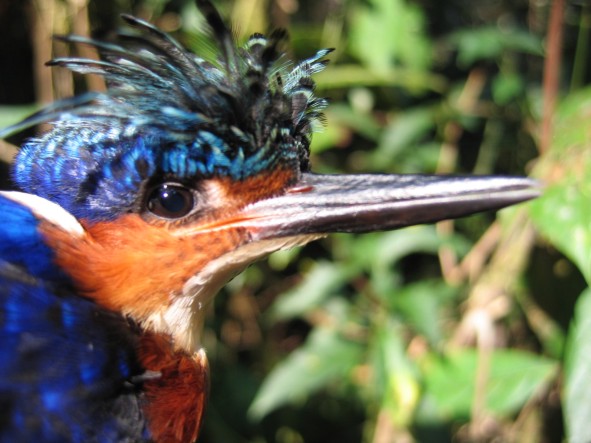
|
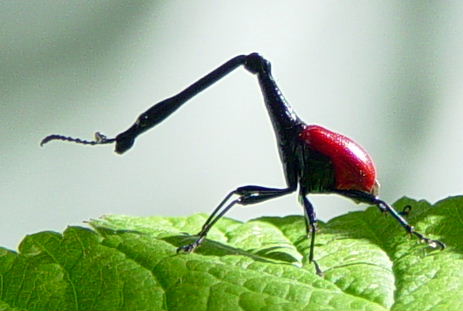
|
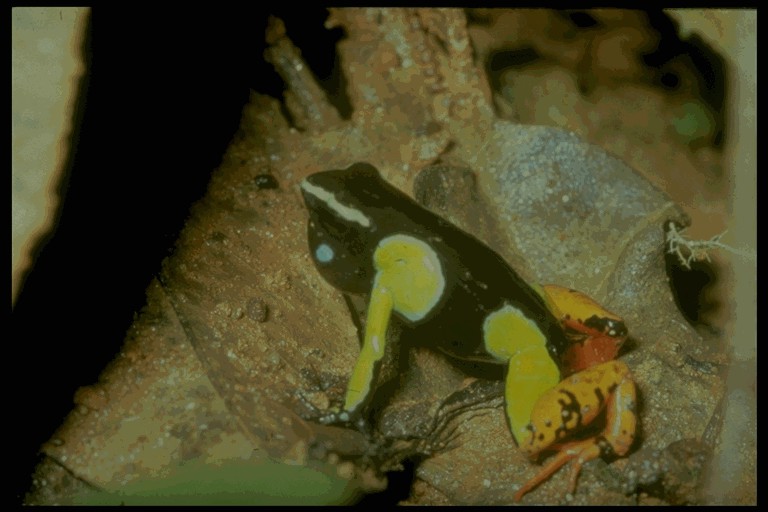
|
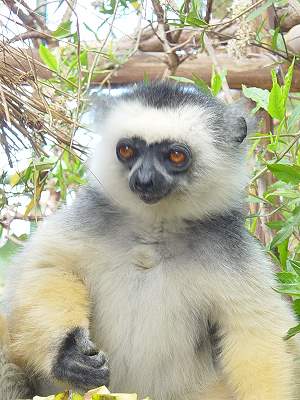
|
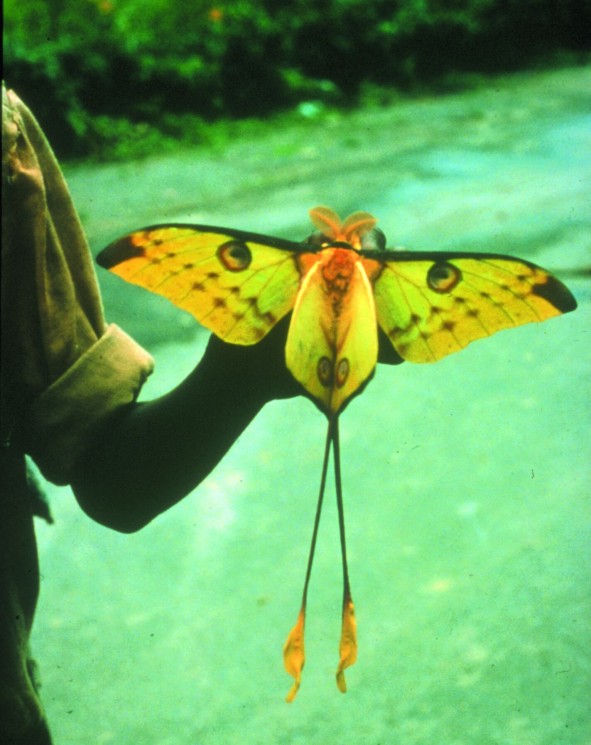
|
|
Photos: martin-pecheur malachite, giraffe necked weevil, coloured mantella, diademed sifaka, and comet moth
|
Also in 2005, we started building trails with treads (because of the mountainous area) which were made from eucalyptus wood, small wooden bridges over the numerous creeks,
enclosures and balustrades at steep viewpoints, two elementary small camping grounds with cabins and campfire sites, cabins for the guards at the entrance and the like. The nature
trails pass by a dense population of various orchids. Various animals can be watched at dedicated places: The diurnal and nocturnal lemurs, like the biggest Madagascan lemur, the
indri, the most beautiful lemur, the diademed sifaka, the rarest like the aye-aye or the hairy-eared dwarf lemur or the smallest primate of the world, the mouse lemur. Along the creeks,
streams and waterfalls, a huge number of different species of frogs can be found. Many of them are still unknown (like the reptiles) and not yet scientifically specified (in the
Andasibe area there are more than one hundred different species of frogs). At the stone pit and in the tree tops you can find a lot of wonderful, coloured birds. Beside the creeks and
little lakes, there are conglomerations of huge old dragon trees, and from the heights like the Pico de Maromiza (753 miles in height; Maromiza=Maromizaha means "see a lot")
you have a wide view over the original mountainous rain forests but also over many destroyed areas.
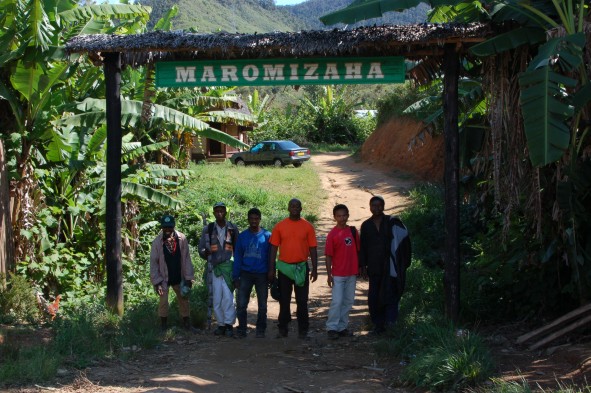
|
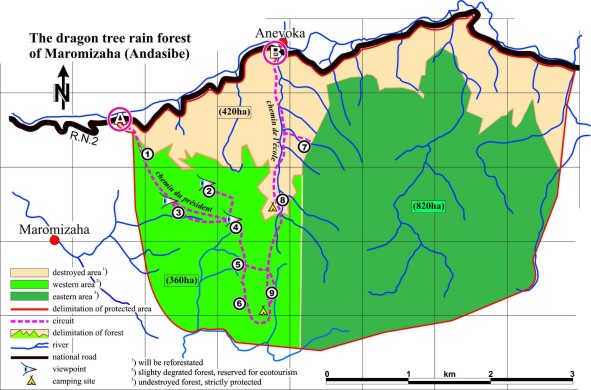
|
|
Entrance to the protection area Dragon Tree Rain Forest Maromiza (in the background: guard cabins, information boards etc.)
|
Unfortunately, the spirit of the president and his young staff (many of them had been educated in Germany) has not yet achieved acceptance in many authorities with regard to
transparency and efficiency of their work and presentation. This is often to the disadvantage of their own people. In our request for extension for the LSBW dated February 9th, 2007,
we constituted that our works on eco-tourism had virtually been completed. But the responsible officers of the authority waters and woods took a lot of time with their final acceptance.
The amount of money which they demanded for the acceptance seemed exorbitantly high to us, so we refused. Due to our administrative appeal at the head office of the administration,
the amount was halved, but again we had to wait a long time for the final acceptance. Because of the challenging climatic circumstances in the rain forest, especially during the rains,
a renewal of the trails, treads, and shelters had since become necessary. Therefore, the people of Andasibe-Anevoka can only profit from the revenue of entrance fees, product selling
and the like after a long delay.
Environmental education
The posters and leaflets financed by the LSBW mainly contributed to the environmental education by the NAT team, but also the acquired library with many reference books,
instruments and equipment. The posters and leaflets were also spread, exposed, and discussed at the schools of Andasibe and its communities, as particularly the youth showed
special interest in their nature. At presentations in Moramanga, the provincial capital, and in the capital Antananarivo, the NAT foundation showed posters and large size photos
and also spread the leaflets at a stand. The visitors became informed on the biodiversity of the Maromiza wood, and its protection was promoted in lively discussions. Two further
presentations on the same range of topics had been arranged in the community of Andasibe together with the mayor. They were even more important insofar as the people of the village
were confronted with the sense of the conservation of their flora and fauna. The conservation of the natural resource "rain forest" and its utilisation by the eco-tourism
(and thus their income) produced special interest during these detailed talks, but also the make-work projects for reafforestation, education by specialists in collecting seeds and seedlings,
establishing tree nurseries and growings as well as the planting of the young trees for reafforestation. The education as a walking guide over many months by our head of the station
Harisoa in our grand-scaled classroom as well as in nature was willingly accepted.
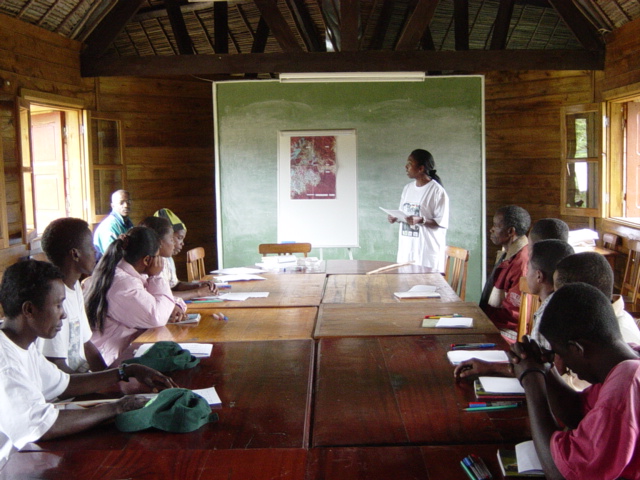
|
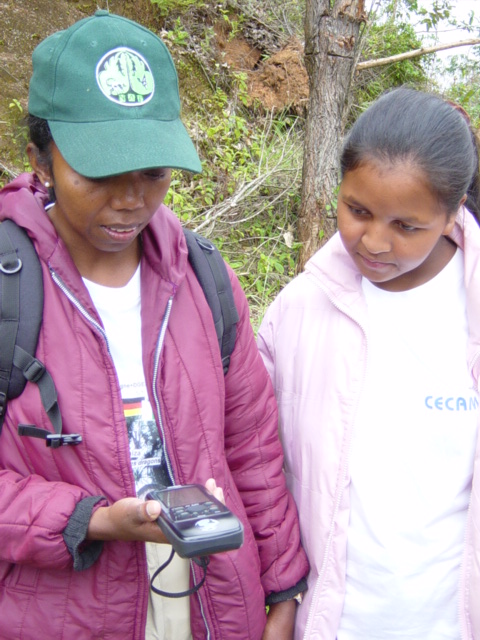
|
|
Education of the NAT tourist guides in the classroom and GPS education outside
|
Reafforestation with autochthonal plants with involvement of the people
The recovery of the natural rain forest is of utmost importance for the conservation of the biodiversity and in this case even for the linking of two ecosystems in the eastern
rain forest of Madagascar. Also in this matter, there has been a successful collaboration between the NAT foundation, lead-managed by the Madagascan forest directorate, the
Madagascan administation for nature conservation ANGAP as their professional partner, and - besides the WWF - the greatest organisation for nature conservation, the Conservation
International (CI). First, a dedicated group of workers of the village was educated in the multifaceted flora and its seedlings and seeds of the still existing rain forest. Then, a large-scale
collection of the seedlings and seeds and their packing into little plastic bags with some humus soil was carried through. In the meantime, other workers established professional tree
nurseries where the close-packed seedlings and seeds continued growing, protected with straw mats against the tropical sun. When they had reached the required size, depending on the
tree species, they were placed into a prepared free area following a special system for reafforestation of autochthonal plants. This was often a little celebration for the poor people of the
village. Despite rain (what is common in the rain forest), up to 60 families surged to the large planting area. In the beginning, a song was sung, and the priest of the community spoke
some encouraging words, prayed and blessed the undertaking. The presents of the NAT foundation like bags of maize, corn and beans as well as a football for the people were not to
be forgotten, and then the plants and shovels were taken to the plant holes which had been prepared with a thin layer of humus soil (of course, at the end of the day, the people received their
well-deserved wages). Accurately, the plants were inserted deep enough, so that the next cyclone would not wash them away immediately. By this means, over the planting years
from 2005 to 2007, 100,000 young rain forest trees were planted and cultivated on an area of around 250 acres. Yet not only eucalyptus and pine species were used, as it is
common for reafforestation measures, but a large variety (first 29, later up to 57) of the different tree species of the adjacent original rain forest.
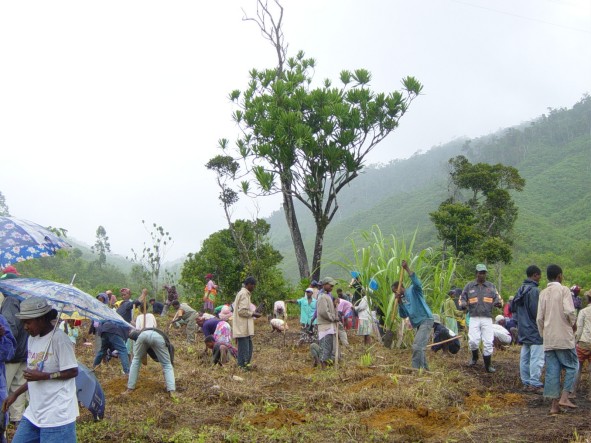
The people at reafforestation
The result of the works of the NAT foundation, which is a relatively small non-governmental organisation (NGO), might probably have produced interest in an international public.
We were pleased that we could make allowance for the desire of the Nobel Peace Prize Laureate AL GORE in his well-known book "An Unconvenient Truth"
(page 305 in the German release of 2006) insofar as our foundation was the only one which was mentioned on the referred web site
www.prima-klima-weltweit.de
with our method of resolution "Reafforestation of the dragon tree rain forest Maromiza using autochthonal plants".
Altogether, the six years of activity of the NAT foundation for the provision of work for the poor people by the managament of conservation and cultivation of the dragon tree rain
forest Maromiza have been extraordinarily fruitful. The final deforestation of this core and link of the eastern Madagascan rain forest could be prevented by the activities of the
NAT foundation just in time. Its six national parks were declared a "world nature heritage" by the UNESCO on July 27th, 2007. The complete Maromiza area of 4,000 acres
in size is being declared a nature reserve due to an application of the NAT foundation and the information of the ministry, and shall be included into the world heritage. Furthermore,
the project has been included into the Madagascan CO2 sequestration activities. According to calculations of experts, the reafforestation of the present 250 acres achieves a
CO2 sequestration of 1,000 tons per year, that is a CO2 sequestration of 40,000 tons within the scheduled growing time of 40 years. A demonstration area of 10 acres has been
established as a buffer area, for education and utilisation by the people. Here, fruit trees, vegetables, maize, pineapples and other agricultural crop can be cultivated; the first crop
yields have already been achieved. The investigations on endemism and the probably highest biodiversity of Madagascar on a very small area allowed to show the public and the
eco-tourists the high value of the Maromiza wood and its fauna. The installations for a cautious yet still attractive eco-tourism allowed to establish a lasting income for the local
population.
As the cooperation contracts have now expired, the work of the NAT foundation has terminated. The "help for the people to help themselves" has been provided.
Now the further management for Maromiza will be taken over by the Maromanga forest directorate with the group for primate research and nature conservation (Groupe d’ Etude et de
Recherche sur les Primates de Madagascar, GERP), whereat the Kreditanstalt für Wiederaufbau is willing to make a financial contribution after the final declaration of Maromiza as a
nature reserve and the assignment to ANGAP.
Also the further reafforestation works will be carried out by the people of Maromiza-Anevoka, now by GERP instead of the NAT foundation. Besides the above mentioned sponsors,
it was mainly due to the financial support of the Landesstiftung Baden-Württemberg, that this large project could be successfully realised and finalised, especially for a
relatively small non-governmental organisation (NGO) like the NAT foundation.
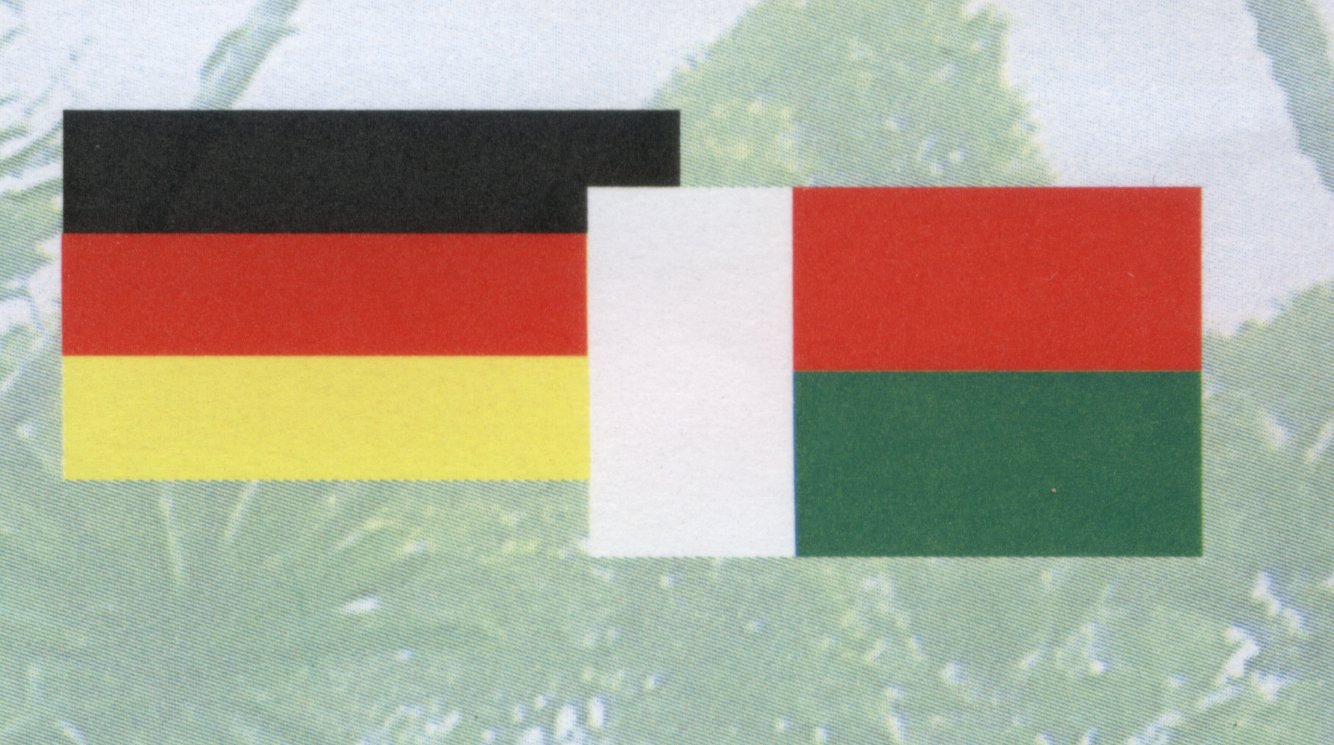


April 01, 2007:
Between ring-tailed lemurs and chimpanzees
The Karlsruhe Zoo also takes part in the pan-European „Madagascar Conservation Campagne“ of the EAZA (European Association of Zoos and Aquaria)
from April to December 2007. The opening ceremony with the 1st mayor of the city took place in the hall of the monkey house on March 30th, 2007. For the inaugural address,
the Zoo had invited the Foundation for Tropical Nature and Species Conservation (NAT) as a professional partner.
The president of the NAT foundation, Helmut Zimmermann, first thanked for the invitation by the director of the zoo, Dr. von Hegel, and her active assistants Dr. Clemens Becker
and Dr. Ulrike Stephan. He gave an account of his experience in the moore area Torotorofotsy in Madagascar, which had been integrated into the RAMSAR list of the world's most
important wetlands (similar significance as an eco-label like "world nature heritage") by the UNESCO due to his works and his initiative. He also mentioned the difficult
works in the Maromiza rain forest, where he and scientific assistants could prove the highest biodiversity of Madagascar, the development of a subarea for a „cautious
tourism“, as well as the reafforestation of burnt down woods using about 100,000 young rain forest trees which had been grown in NAT tree nurseries. He thanked all sponsors
for their financial support, ranging from the Landestiftung BW, the Conservation International/Tany Mewa, PrimaKlima over pet shops like Kölle Zoo to working groups like
the interest group Phelsuma and private initiatives.
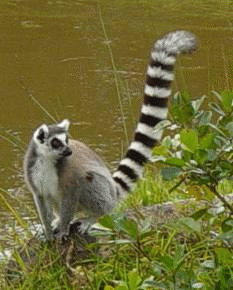 Photo © H. Zimmermann, NAT
Photo © H. Zimmermann, NAT |
The vice president of the NAT foundation, Dr. Peter Wüst, illustrated the organisation and the goals of the foundation (which celebrates its tenth anniversary in
this year), which are the conservation of the biodiversity and the protection of the rain forests, especially of the Maromiza dragon tree rain forest in Madagascar, and its
reservation and partial reafforestation, which is also a small contribution to the reduction of the global CO2 emissions. Thereby he pointed out that the work of the NAT
had gained ultimate recognition with the conferring of the national order of the Republic of Madagascar to Helmut Zimmermann by the Madagascan President Marc
Ravolamanana.
While the male chimpanzee was resolutely knocking against the windows of his cage on one side of the hall, thus protesting against the numerous
participants of the Madagascar event, a big family of ring-tailed lemurs accompanied the visitors on the other side with reliance and curious friendliness.
|
March 12, 2007:
100,000 young rain forest trees and the giraffe necked weevil
The species-rich Maromiza dragon tree rain forest near Andasibe had partly been destroyed by deforestation as well as slashing and burning. In the last two years, the German
Foundation for Tropical Nature and Species Conservation (NAT) has already reafforested with over 39,000 young rain forest
trees of about 30 different autochthonal species with the financial support of the Landesstiftung Baden-Württemberg, PrimaKlima weltweit and other sponsors. Now, over
60,000 seedlings in the NAT owned tree nurseries are ready for planting (financed by Tany Meva, Madagascar). Thus, 100,000 small trees – no pines or eucalyptus but
home-grown tree species – will be newly planted soon.
According to the present scientific survey, this rain forest probably accomodates the highest density of species in Madagascar on an area of only 4,000 acres, amongst others
also the famous, bizarre giraffe necked weevil Trachelophorus giraffa (which had inadvertently been named bizarre guitar necked weevil on December 6, 2005 on our
nature reserve page). The males have a very long neck, nearly as long as the whole body. It can often be found in the Maromiza wood, yet it is difficult to discover due to the size
of its neck of only 0.5 inches and its body of only 0.55 inches. Furthermore, it flies away quickly at appropriate air temperature when it is touched.

Giraffe Necked Weevil (Photo: © H. Zimmermann NAT)
October 29, 2006:
News from the nature reserve „Dragon Tree Rain Forest Maromiza“ near Andasibe of the German "Foundation for Tropical Nature and
Species Conservation “ (NAT, 2006)
Currently, bad news from Madagascar is increasing concerning spacious forest fires „feux de brousse“, for example
- in the area of the Anjozorobe corridor (Les Nouvelles, October 28, 2006)
- la réserve Ankarafantsika (L’Expresse, October 23, 2006)
- Aires protégées Montagne de Français-Antsiranana (Tribune, October 23, 2006)
- la forêt d’Andranobe-Ifaty (L’Express, October 21, 2006)
- Mandritsarakely-Ambondromany (Les Nouvelles, October 4, 2006)
Due to an efficient observation of the Maromiza nature reserve by the NGO NAT and further activities in cooperation with the local population for nearly six years, no
more forest fires have been recorded in the only link between the northern and the southern rain forest of Madagascar near Andasibe, just on the contrary:
2004: Precise planning for the afforestation of the destroyed part of Maromiza (see Klaus Heimer: „Einzigartiger Regenwald in Madagaskar
gerettet“, Rheinpfalz, February 10, 2004)
2005: Beginning of the first reafforestation of 4,000 young autochthonal trees together with the local population in the presence of the Madagascan
authorities (see www.madagasikara.de, Madagascan television and newspapers dated April 11, 2005)
2006: Further afforestation of 34,000 seedlings of 36 different autochthonal tree species. 60 villagers and Madagascan tree specialists became employed.
Two new tree nurseries were established and seeds and seedlings were cultivated for further planting.
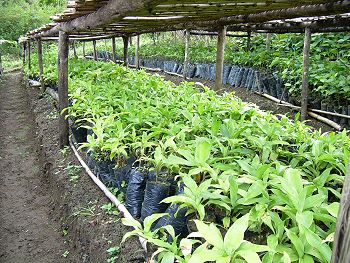 As seedlings could not be bought, NAT themselves and some tree specialists have collected seeds and seedlings of
36 different tree species from the adjacent rain forest area and grown in the ad hoc established tree nurseries until they were ready for planting. From these tree nurseries,
36,000 young trees were placed into a prepared free area in July and August.
As seedlings could not be bought, NAT themselves and some tree specialists have collected seeds and seedlings of
36 different tree species from the adjacent rain forest area and grown in the ad hoc established tree nurseries until they were ready for planting. From these tree nurseries,
36,000 young trees were placed into a prepared free area in July and August. |
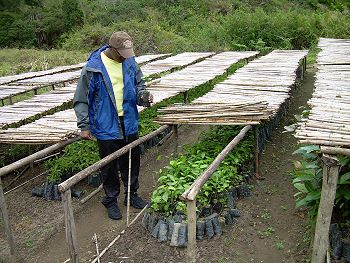 The biologist Dr. Blanchard Randrianambibina checking the seedlings for their survivability before bedding out.
The biologist Dr. Blanchard Randrianambibina checking the seedlings for their survivability before bedding out. |
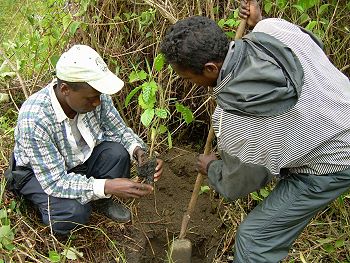 Workers, bedding out the seedlings
Workers, bedding out the seedlings |
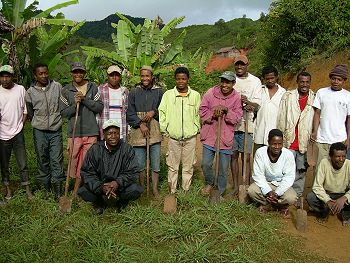 All in all, 60 poor villagers had been employed for the reafforestation in July and August 2006. The earnings which they
received for their work improved their standard of living, but they were also sensitised for the value of their work and for the conservation of the rain forest.
All in all, 60 poor villagers had been employed for the reafforestation in July and August 2006. The earnings which they
received for their work improved their standard of living, but they were also sensitised for the value of their work and for the conservation of the rain forest. |
|
These works only became possible due to the financial support of: Landesstiftung Baden-Württemberg - Stiftung Entwicklungszusammenarbeit BW,
Conservation International - Tany Meva, Kölle Zoo, interest group Phelsuma, PrimaKlima weltweit - Märkisches Landbrot, Förderkreis NAT.
Thus, the NAT foundation not only contributes to the protection and conservation of the Maromiza rain forest area with its unique biodiversity in Madagascar,
but also to the overall „Projet conservation de carbon – Restauration du Corridor Vohidrazana-Maromiza-Mantadia“.
|
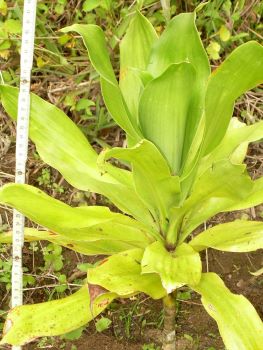 The young dragon tree of the year 2005 is already about 19 inches high.
The young dragon tree of the year 2005 is already about 19 inches high. |
December 06, 2005:
German group of scientists with Madagascan assistants to investigate the Maromiza dragon tree rain forest near Andasibe
At the end of the year 2005, a German group of scientists with Madagascan assistants left for the Maromiza dragon tree rain forest near Andasibe for the third time to investigate
its bird life and mammal fauna. The group worked under the direction of Dr. Friederike Woog (birds) and Kathrin Marquart (small mammals) of the Staatliches Museum für
Naturkunde Stuttgart (SMNS). Especially in the almost intact old-growth forest of the area, exciting results and new species may be expected again.
So far, the researchers from Stuttgart classified 77 species of bird, 21 species of mammal (lemurs excluded), 811 species of moth (including the comet moth, which is the biggest
with up to 11 inches in size), and 1001 different beetles of 10 species (including the bizarre giraffe necked weevil).
Already before, assistants of the Groupe d'Etude et de Recherche sur les Primates de Madagascar (GERP) working under the direction of Prof. Dr. Berthe Rakotosamimanana
had also discovered new species among the lemurs of the Maromiza wood, thus the number of lemur species has by now increased to 16, which is the highest biodiversity of lemurs
in a nature reserve in Madagascar. Much to the regret of all primatologists and nature lovers, Prof. Dr. Berthe Rakotosamimanana has died unexpectedly in November 2005.

Giraffe Necked Weevil (Photo: © H. Zimmermann NAT)
April 09, 2005:
NAT campaign for tree planting
The Foundation for Tropical Nature and Species Conservation (NAT), which is the only German organisation for nature conservation in Madagascar, realises the first campaign for
reafforestation of the partly degraded Maromiza wood of the NAT near Anevoka-Andasibe on April 9, 2005.
Instead of eucalyptus and pines, only home-grown autochthonal tree species of the Maromiza rain forest were used for planting, which had been grown from seeds and seedlings
in the NAT tree nurseries.
Thus, the NAT foundation contributes to the reafforestation of destroyed and eroded rain forest areas and also to the conservation and protection of the biodiversity of this
unique dragon tree rain forest. Until now, 16 species of lemur, over 66 species of amphibian, more than 63 species of orchids and many other rare animal and plant species have been
discovered on this area of 4,000 acres in size.
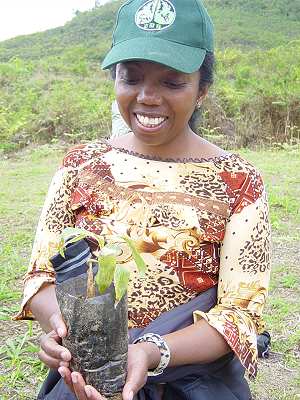 The head of the NAT station
The head of the NAT station
with plants from the rain forest |
 Diademed Sifaka (Propithecus diadema diadema)
Diademed Sifaka (Propithecus diadema diadema) |
February 02, 2005:
On February 2, 2005, the „WORLD WETLANDS DAY“,
the moore area TOROTOROFOTSY near Andasibe/East Madagascar had been integrated into the RAMSAR list of the world's most important wetlands as the fourth wetland of
Madagascar.
The only German organisation for nature conservation which works in Madagascar, the „Foundation for Tropical Nature and Species
Conservation (NAT)“, has assessed an uncommonly high biodiversity in this area after years of investigation: Nearly 200 (thereof around 90% endemic) vertebrate species like lemurs and other mammals, birds, reptiles and amphibians – including the famous Madagascan Golden Frog
Mantella aurantiaca, which only lives here and nowhere else in the world –, and furthermore 63 species of orchids and many other rare plant species.
Therefore, on Feburary 22, 2001, the NAT foundation had successfully submit an application at the Madagascan government (Comité National RAMSAR, DGEF) to
integrate the rain forest moore area Torotorofotsy into the RAMSAR list of the world's most important wetlands by the RAMSAR commission in Gland (similar significance as an
eco-label like „world nature heritage“ of the UNESCO).
Madagascan Golden Frog (Mantella aurantiaca)

Autumn 2004 (scheduled):
TV film on eco-tourism and nature conservation in Madagascar on 3SAT. (HZ)
October 25, 2004:
ANGAP (the only institution for nature conservation of the Madagascan ministry of the environment) and the NAT foundation submitted the common project for nature conservation and development MAROLAMBO at the European Union in Brussels for financial support.
October 2004:
German-Madagascan culture weeks (Semaines Culturelles Germano-Malgaches) in the capital Antananarivo. Participation of the NAT foundation with poster lectures at the university (scientific colloquium "biodiversity") and at the exhibition building of the capital.
October 17, 2004:
The president of the world bank James Wolfersohn visits the Indri conservation area near Andasibe.
May 24, 2004:
The NAT president Helmut Zimmermann was awarded the National Medal of the Republic of Madagascar by the Madagascan president of the senate of Madagascar Guy Rajemison at the Embassy of Madagascar in Falkensee/Berlin.
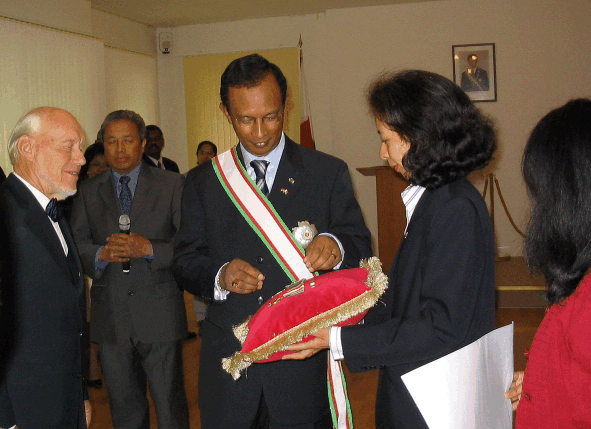
May 15, 2004:
Conference of the Chair with general meeting and NAT lecture, German-Madagascan society, Munich. (HZ)
May 8, 2004:
Conference of the Chair with general meeting and NAT lecture, PRIMA KLIMA worldwide, Düsseldorf. (HZ)
April 3, 2004:
XIV. International Symposium "Threatened parrots" in Bietigheim-Bissingen. (PW)
March 27, 2004:
Visit and guide of the Madagascan president Marc Ravalomanana and his Ministers i.a. in the NAT conservation area "Dragon tree rain forest Maromiza, Andasibe", Madagascar.
December 21, 2003:
TV film (geman) on eco-tourism and nature conservation in Madagascar in the ZDF-Umwelt programme (HZ)
November 3, 2003:
TV film (German-French) on eco-tourism and nature conservation in Madagascar in ARTE (HZ)
October 18-19, 2003:
Annual general meeting with NAT lecture, Interest Group Phelsuma. Göttingen. (HZ)
September 12-13, 2003:
Annual general meeting of the Society for Tropical Ornithology with NAT lecture. Zürich. (HZ, PW)
August 3, 2003:
Talkshow on Madagascar of the "Diplomatisches Magazin" and Radio Berlin. Participants: Presenter Sabina Porn, German Embassador Dr. H.-P. Behr, Madagascan Embassador Dr. D. Andriamandroso, NAT president Dipl.-Ing. Helmut Zimmermann.
July 11, 2003:
Annual general meeting with NAT lecture, German Ornithological Society. Esslingen-Bergheim. (HZ, PW)
June/July 2003:
ZDF TV shooting on eco-tourism and nature conservation in Madagascar (one focus i.a.: "Dragon tree rain forest Maromiza, Andasibe") with protagonists Sonja Ranarivelo and Helmut Zimmermann. The programme was broadcast on November 6, 2003 on ARTE television, on December 21, 2003 on ZDF and on November 28, 2004 on 3SAT.
May 2003:
Reception at the German Embassador Villa Berlin with Ministers i.a., Antananarivo, Madagaskar. (HZ)
Opening of the redecorated German Embassy in Antananarivo, Madagascar. (HZ)
Exhibition in the Madagascan National Library to celebrate the 120th Jubilee of the German-Madagascan Treaty of Friendship with NAT poster, Antananarivo. (HZ)
April 26, 2003:
XIII. International Symposium "Threatened parrots" in Bietigheim-Bissingen (PW)
March 21-22, 2003:
Opening of the new Madagascan Embassy in Falkensee/Berlin (HZ, EZ)
August 31, 2002:
Visit of the Madagascan Embassador Dr. D. Andriamandroso at the Madagascar exhibition Stuttgart. (HZ)
July 23 - September 6, 2002:
Accompanying programme at the great Madagascar exhibition at the Mediothek of the state capital Stuttgart:
July 23 - September 6, 2002: Media presentation "Magic Madagascar"
July 25, 2002: Film night "Madagascar - Lemurs, Chameleons and Baobabs" with expert talk (HZ)
August 23, 2002: Slide show "Dream Island Madagascar" (HZ)
September 2002: Internet Quiz Workshop "Madagascar" (for the youth)
June 29, 2002:
Conference of the Chair with general meeting of the German-Madagascan Society in the new building of the Madagascan Embassy in Falkensee/Berlin. Collection for the recovery
of Madagascar after the crisis with over 1.000,- Euro. (HZ)
June 20-21, 2002:
Visit of the mayor of the capital Antananarivo (and later senate president of Madagascar) Guy Rajemison in Stuttgart (Madagascar Exhibition, reception at the state parliament
of Baden-Württemberg and its president, and various departments of the state capital). (HZ)
June 19 - September 22, 2002:
Special exhibition "Madagascar - Island of Tropical Treasures". A contribution of the NAT foundation and the botanical and zoological garden Wilhelma in Stuttgart,
for the realization of the Rio Convention on biological diversity.
Opening in the presence of the State secretary of the Ministry for Development, Dr. Uschi Eid, of representatives of the new government of Madagascar, the German Embassy
of Madagascar, the Ministry of Finance of Baden-Württemberg, the National Museum for natural history Stuttgart, the Lindenmuseum for Ethnology, Stuttgart and the media (HZ, PW)
April 20, 2002:
XII. "International parrot symposium". Bietigheim-Bissingen. (PW)
October 24, 2001:
"Symposium Ornithology" National Museum for natural history, Stuttgart. (HZ, PW)
October 7, 2001:
Unveiling of the big information boards "Dragon tree rain forest Maromiza, Andasibe" of the NAT conservation area in Madagascar
at the motorway 2 with the German Embassador and Madagascan media. (HZ)
September 7, 2001:
Conference of the Chair and general meeting of the German-Madagascan society, Düsseldorf. (HZ)
June 20, 2001:
"25th anniversary of the Washington agreement of the protection of endangered species in the Federal Republic of Germany, CITES",
ministry of the environment, nature conservation and reactor safety at the forum of the exhibition hall and art gallery of the FRG, Bonn. (HZ)
April 28, 2001:
Conference of the Chair and general meeting of PRIMA KLIMA worldwide, Düsseldorf. (HZ)
April 17, 2001:
"XI. International Symposium" in Bietigheim-Bissingen on conservation breeding projects, veterinary medicine and the protection of the biotopes of threatened parrots. (PW)
January 16 - January 17, 2001:
"Dialogue forum on the report of the World Commission on Dams (WCD)" at the Grand Hyatt Hotel, Berlin. Bundesministerium für wirtschaftliche Zusammenarbeit und
Entwicklung (BMZ) and Deutsche Gesellschaft für technische Zusammenbarbeit (GTZ). (HZ)
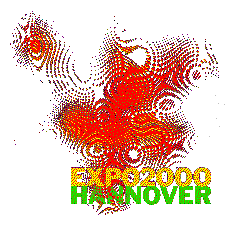
June 1 - October 31, 2000:
World Exhibition "EXPO 2000" in Hannover: Large photo and poster exhibition of the NAT foundation "Juwel
Madagaskars – Region Andasibe" ("Juwel of Madagascar – Region of Andasibe") at the Madagascar stall, hall 12. (see "Current NAT")
May 6, 2000:
8th working conference of the Foundation for Tropical Nature and Species Conservation (NAT) working group at the town hall of the municipal corporation in Boppard/Mittelrheintal.
| 09:00 - 09:45am: | Visit to the exhibition |
| 09:45 - 10:00am: | Welcome and opening of the event by the NAT foundation president and 2nd chairman, mayor of the city of Boppard. |
|
| 10:00 - 10:10am: | Introduction. |
|
| 10:15 - 10:50am: | Amphibiendiversitätszentren in Indonesien.
Dipl.-Biol. JOACHIM KOSUCH, PD Dr. MICHAEL VEITH, Universität Mainz. |
|
| 10:55 - 11:25am: | Pazifikwarane im Indo-Australischen Archipel - Eine äußerst erfolgreiche Invasion.
Dipl.-Biol. KAI PHILIPP, Zoologische Staatssammlung München, Prof. Dr. WOLFGANG BÖHME und Dipl.-Biol. THOMAS ZIEGLER, Zool. Forschungsinstitut und Museum Alexander König. |
|
| 11:25 - 11:45am: | BREAK |
|
| 11:50 - 12:20am: | Die mycoheterotrophen Pflanzen Neuguineas - Portrait einer ungewöhnlichen Lebensweise.
Dipl.-Biol. THASSILO FRANKE, Institut für Systematische Botanik der LMU München. |
|
| 12:25 - 12:55am: | Wo sich Welten treffen: Biodiversitätsforschung anhand der Wasserkäfer Australasiens.
Dipl.-Biol. MICHAEL BALKE, AG Evolutionsbiologie, Freie Universität Berlin. |
|
| 01:00 - 02:40pm: | LUNCH BREAK |
|
| 02:40 - 02:55pm: | "ABC - Aquatic Beetle Conservation" - Inventarisierung und Schutz von aquatischen Lebensräumen in SO Asien: Paradebeispiel Singapur.
Dipl.-Biol. MICHAEL BALKE, AG Evolutionsbiologie, Freie Universität Berlin. |
|
| 03:00 - 03:30pm: | Nutzung von indonesischen Reptilien.
Dipl.-Biol. MARK AULIYA, Zoologisches Forschungsinstitut und Museum Alexander König. |
|
| 03:35 - 04:05pm: | Waldbrandproblematik in Kalimantan als Beitrag zum Klima- und Naturschutz.
Gesellschaft für technische Zusammenarbeit. |
|
| 04:10 - 04:35pm: | BREAK |
|
| 04:35 - 05:35pm: | Siberut, eine Insel ohne Vergangenheit - auch ohne Zukunft?
Dr. KARL-HEINZ PAMPUS, Universität Frankfurt. |
|
| 05:40 - 06:00pm: | Naturschutz durch Tourismus? Konzeptvorschlag am Beispiel des Ujung Kulon National Park auf West Java.
ODA HAGEMEIER, Geographisches Institut, Universität Mainz. |
|
| 06:00 - 06:20pm: | BREAK |
|
| 06:25 - 06:55pm: | Inselökologische Aspekte der Entwicklung von Karimunjawa, Java See, Indinesien.
Dr. FRIEDHELM GÖLTENBOTH, Universität Hohenheim. |
|
| 07:00 - 08:00pm: | Zurück in die Steinzeit - bei den Korowai in Irian Jaya.
HARALD MELCHER, Gernsbach. |
|
Entrance-fee DM 10,- (DM 8,- for juveniles, students, pensioners). The net profits will be given to the NAT foundation for the "Project for the protection of the rain forest Salawati".
The foundation is recognized as "in the public interest". We give receipts for donations and gifts in kind above DM 100.- (EUR 50,-). Preliminary donation account 101198703 at the Kreissparkasse Simmern/Hunsrück
(BLZ 560 517 90). Mailing address: Verein Natur- und Artenschutz in den Tropen, Wieselweg 3, 56154 Boppard.
April 1, 2000:
"X. International Symposium" in Detmold on keeping, breeding and protection of threatened parrots. (PW)
Feburary 3, 2000:
"Menschen oder Lemuren?" Slide show (HZ) due to the annual main meeting of the Deutsch-
Madagassischer Verein, Esslingen.
December 4, 1999:
"Die Schönsten aber sind die Dendrobaten – Lebensräume, Zucht und Arterhaltung von
Pfeilgiftfröschen". Slide show with collection campaign (HZ) Stadtgruppe Stuttgart der Deutschen Gesellschaft für Herpetologie
und Terrarienkunde.
October 9, 1999:
9. meeting of the NAT working group and the NAT foundation in Stuttgart, Maurisches Schlößchen of the Zoologisch-botanischer
Garten WILHELMA.
August 31 - September 2, 1999:
II. Colloque International Biogéographie de Madagascar, Paris. Louise Holloway (reading and slide show): "Catalysing rainforest
restoration" and Helmut Zimmermann (reading and slide show): "La Protection de la Biodiversité des Forêts et Marais de
Torotorofotsy à Andasibe, Madagascar-Est".
July 27 - September 26, 1999.
Poster stall of the NAT foundation in exhibition "Artenschutz" Karlsruhe Zoo + Bundesverband für fachgerechten
Natur- und Artenschutz, Protector: Minister of the Environment Mrs. Staiblin.
June 11, 1999:
"Geheimnisvolles Madagaskar – Orchideen", Reading with slide show and collection campaign (HZ), Deutsche
Orchideengesellschaft, Landesgruppe Württemberg, Esslingen.
April 30 - May 1,1999:
Madagascar Conference Boppard 1999 protected by the mayor of the city of Boppard. Lectures by Prof. Dr. A.
Mahafa (Deutsch-Madagassische Gesellschaft), Dr. K. Böswald (PRIMA KLIMA weltweit), Dipl.-Lwt. K.D. Bühner
(Gesellschaft für Technische Zusammenarbeit), MSc. Louise Holloway, London und Dipl.-Ing. (FH) H. Zimmermann (Stiftung NAT
und AK NAT), Prof. Dr. W. Böhme (Zoologisches Forschungsinstitut und Museum Alexander König), Dipl.-Volksw. Annette
Schiller (Deutsch-Madagassische Gesellschaft), Prof. Dr. V. Altenbach (Universität München), Pfarrer G. Hekler
(Deutsch-Madagassischer Verein), M. Grubenmann, Zürich (Stiftung und AK-NAT). Completed by a video, music from Madagascar,
big poster exhibition of nature conservation, exhibition with satellite photos, books, stamps, jewellery, Antaimoro paper, water colours,
wooden and clay sculptures and inlaid work, typical Madagascan instruments and typical commodities, "recycling-art", and the like.
May 8, 1999:
Bietigheim-Bissingen: 9th International Symposium for threatened parrots (veterinary medicine, dietetic physiology, evolution). The final schedule can be ordered from the
vice president, Dr. Wüst.
November 27-29, 1998:
Madagascar Symposium of the "Institut für Wissenschaftliche Zusammenarbeit mit Entwicklungsländern", "Deutsch-Madagassische Gesellschaft" and "Konrad-Adenauer-Stiftung"
in Rottenburg/Neckar, Germany. Conference on conservation areas and satellite pictures of Madagascar. (HZ)
November 14, 1998:
Specialist symposium "Bundesverband für fachgerechten Natur- und Artenschutz", "Kölle-Zoo" and "Naturkundemuseum Stuttgart" in Stuttgart, Germany. Conference on conservation
areas and satellite pictures of Madagascar. (HZ)
November 7, 1998:
Conference of the "Deutsch-Madagassische Gesellschaft" in Kassel, Germany, with presentation of the project Andasibe, restauration of the rainforest and puchase of
satellite pictures. (HZ)
October 24, 1998:
Annual general meeting PRIMA KLIMA worldwide in Düsseldorf, Germany, with presentation of the project Andasibe, restauration of the rainforest and puchase of satellite pictures. (HZ)
September 28, 1998:
7th conference of the "Working Group for Tropical Nature and Species Conservation" (AK-NAT) and of the NAT Foundation in Stuttgart, Germany, at the "Maurisches Schlößchen" of the
"Zoologisch-botanischer Garten WILHELMA".
August 3-6, 1998:
Première Rencontre Scientifique Germano-Malagasy "Madagascar: Perspectives de Développement – Croissance de la Population et Croissance Economique contra Sauvegarde de la
Nature" in Mahajanga, Madagaskar. Helmut Zimmermann "Coopération Germano-Malagasy pour la conservation de la biodiversité en consideration du développement durable en accord
avec la nature – Projet Andasibe, Madagascar d'Est" ("Deutsch-Madagassische Kooperation zur Erhaltung der biologischen Vielfalt bei nachhaltig-naturverträglicher Nutzung – Projekt
Andasibe/Madagaskar"). (HZ)
June 11-13, 1998:
Workshop "Tropische Regenwälder, Überleben durch Schutz und/oder Nutzung" in Berlin of the "Deutschen Umwelthilfe". Helmut Zimmermann "Presentation of the Madagascar projects".
(HZ)
June 6, 1998:
Conference "Bundesverband für fachgerechten Natur- und Artenschutz" in Hambrücken. Helmut Zimmermann, poster exhibition "Naturschutzprojekte Madagaskar". (HZ)
May 2, 1998:
6th conference of the NAT Working Group in Boppard/Rhein, old Town Hall.
February 6-11, 1998:
Madagascar Days of the NAT Working Group and the NAT Foundation in Bietigheim-Bissingen with lectures, music, and exhibitions.
December 3-5, 1997:
Ministère des Eaux et Forêts, ANGAP, ONE et al.: Conference on the environment and development on Plan Environnement II in Antananarivo, Madagaskar. Helmut Zimmermann
"Presentation of the goals of the NAT Working Group". (HZ)
October 21-25, 1997:
Bundesamt für Umweltschutz + Bundesverband für fachgerechten Natur- und Artenschutz: Symposium "Nachhaltige Nutzung". International academy for nature conservation on
Vilm island near Rügen. Helmut Zimmermann "Unternehmen Goldfröschchen – ein Fallbeispiel für nachhaltig-naturverträgliche Nutzung". (HZ)
October 1-2, 1997:
World Bank Group, Credit institute for rehabilitation: Environment Conference, Frankfurt/Main. (HZ)
September 18-21, 1997:
Documentation Centre for Species Conservation and the 100th anniversary of the "Aquarien- und Terrarienverein" at the St. Martin Castle, Graz (Austria). Helmut Zimmermann "Das
Madagaskar-Goldfröschchen – ein Schutzprojekt im Regenwald". (HZ)











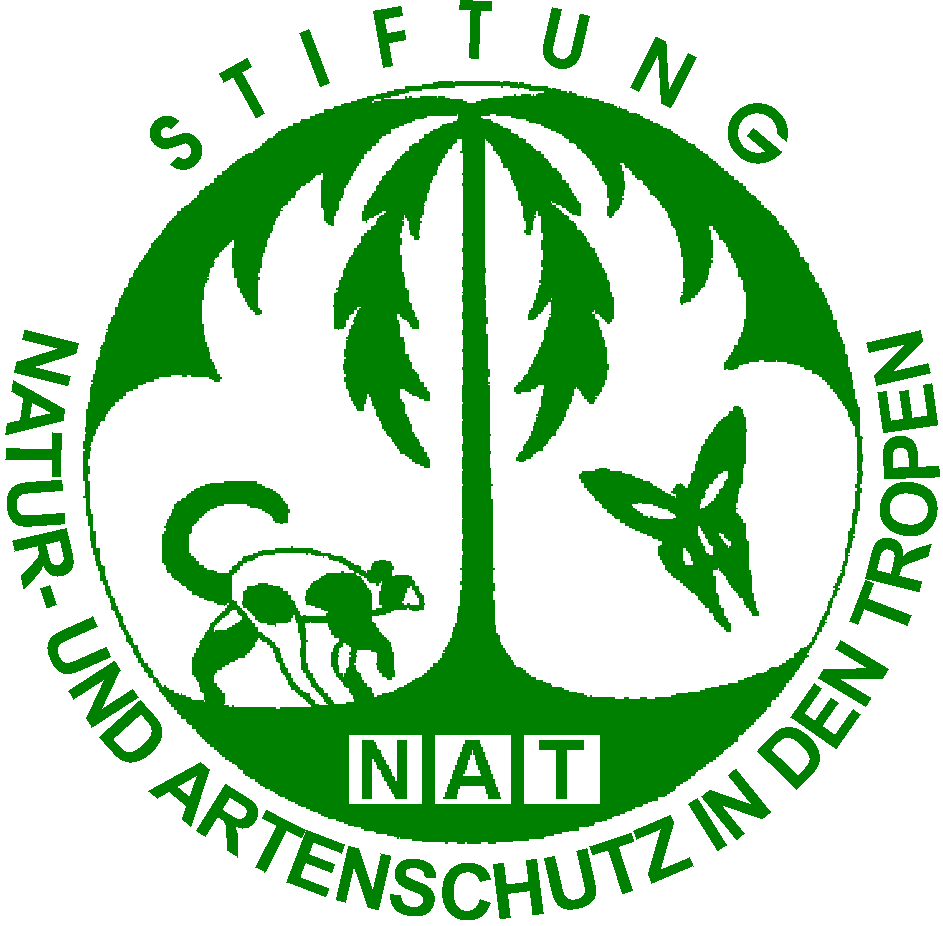


 Photo © H. Zimmermann, NAT
Photo © H. Zimmermann, NAT 






